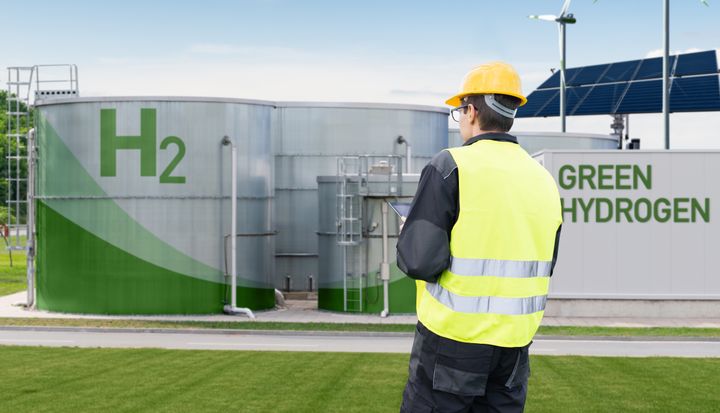Researchers: If Power-to-X is to be a real climate solution, the state needs to use the stick
Despite the massive hype surrounding Power-to-X (PtX), most of the world's announced green hydrogen projects lack financing. The market is deemed far too risky by stakeholders. And, there are many potential pitfalls. According to the authors of a study from the University of Copenhagen, actors must be ‘compelled’ to invest in a genuinely green manner.

Green hydrogen has long been touted as the climate-friendly energy solution of the future. Indeed, there has been no shortage of hype surrounding Power-to-X – which converts green electricity into hydrogen and other molecules. In Denmark, politicians have referred to PtX as a cornerstone of climate policy and hydrogen as the country's next "export fairy tale."
While one grand hydrogen project after another has been announced, both in Denmark and around the world, the truth is that widespread private investment has yet to materialize. As such, many hydrogen projects have been delayed, abandoned or are hanging on by a thread. Globally, projects that have reached a final investment decision – meaning that funding has been allocated or that construction is underway – account for only 4% of the projected hydrogen production in 2030.
Social scientists Oliver Bugge Hunt and Joachim Peter Tilsted from the University of Copenhagen’s Department of Food and Resource Economics conducted a study that looks into why these investments have yet to materialize at scale. Through hours of interviews with industry stakeholders, reviews of documents and their participation in conferences and workshops, the researchers have identified the main reasons behind the lack of investment in green hydrogen.
“We wondered why no one is investing in an industry that is so massively hyped and talked about so much. At the same time, it's concerning that something with the potential to accelerate the green transition is struggling to get off the ground. What our study shows is that green hydrogen is simply seen as a bad investment,” says Oliver Bugge Hunt.
Overall, the study concludes that, among investors and energy developers, the prevelant view is that the risks associated with hydrogen projects far outweigh any expected returns.
“Investors operate on capitalist principles, where they seek to invest their wealth in ventures that they believe will provide what they deem to be a proper return. Currently, hydrogen projects don’t offer them any assurance in that regard – which is why they aren’t investing in them,” says Joachim Peter Tilsted.
Regulatory and infrastructure uncertainty
Investor uncertainty partly stems from the fact that the electrolysis technology that Power-to-X (PtX) relies upon is still relatively untested at the necessary scale. This raises doubts about whether PtX plants can perform as expected, making the costs and revenue potential – which run into the billions – highly uncertain. Furthermore, it is a new field with ever-evolving regulations:
“Investments are dependent upon requirements for environmental approval, safety and determining when a product can be classified as green hydrogen. And then there's the infrastructure. When will pipelines be laid to transport hydrogen? What will it cost to use them? These questions remain unanswered and are in constant flux,” says Hunt.
For instance, in October, the Danish government announced that a planned hydrogen pipeline to Germany would not be established until 2031 at the earliest, whereas the previous target was scheduled for 2028.
“All of these uncertainties and unanswered questions put developers at a disadvantage when negotiating contracts on timelines and deliveries with buyers. Oil and gas remain more attractive investments where risks expectations are stabilized and the returns higher,” says Joachim Peter Tilsted.
Oil and gas companies remain the favourites
In addition to pension funds and private equity firms, potential green hydrogen investors also include oil and gas companies. But despite the fact that most oil and gas giants have announced large-scale PtX projects, very few of them allocate more than a fraction of their investments towards PtX.
According to the study, large oil and gas companies are actually better positioned than green energy companies to finance large-scale hydrogen projects, as the hydrogen industry has more in common with the oil and gas sector than with, for example, wind and solar. These companies can leverage their expertise, infrastructure and established relationships with potential buyers.
“Moreover, in recent years, oil and gas companies have generated enormous profits and are well-capitalized to make these types of investments,” says Hunt, while highlighting the downside of their advantageous position as well:
“Social science research shows that oil and gas companies are generally bad at green sector innovation and investment. This is precisely because returns on oil and gas are higher. Consequently, there is a concern that hydrogen will become a way for oil and gas companies to greenwash their images, barring any sufficient incentives to truly drive the sector forward and phase out fossil fuel production.”
More stick than carrot needed from the state
According to the researchers, the goal should not be to exclude oil and gas companies from the hydrogen market, but rather to leverage their expertise and resources while simultaneously forcing them, through state intervention, to phase out fossil fuels.
This ‘disciplining’ can be implemented by taking steps to eliminate subsidies and tax benefits for fossil fuels, mandating active phase-out requirements, tightening CO2 taxes, and redirecting financing away from new fossil-based projects, which remains immense.
To ensure a phase in, the state could also introduce and strengthen blending mandates that require a certain percentage of fuels to be green, or provide price guarantees for new green products.
Carrots alone, specifically state subsidies for green hydrogen, won't be enough to meet the challenge though – not if the ultimate goal is a green transition, according to the researchers. While subsidies could mitigate risk and make the market more attractive for investors, the researchers emphasize that climate change demands far more robust action.
Joachim Peter Tilsted points out that “oil and gas companies have no interest in reducing their fossil fuel profits. Subsidies alone won't suffice. Without concurrent efforts to phase out fossil fuels, expand renewable energy sources like wind and solar, and ensure climate-literate use of green hydrogen, power-to-x risks becoming another layer on the fossil energy system. Besides not ensuring a genuinely green transition, a subsidy-only approach would lead to a limited number of private actors reaping any rewards.”
***
ABOUT POWER-TO-X
- Power-to-X (PtX) refers to a set of technologies that can convert surplus electricity from renewable energy sources into CO2-neutral hydrogen. Green hydrogen can be used directly, as liquid fuel in vehicles such as trucks and ships, or be further converted into products such as ammonia or methanol, that can be used as fuel or raw materials for industry.
- The conversion process uses electrolysis, an electrochemical process whereby water is split into hydrogen and oxygen.
- Power-to-X allows for the use of some solar and wind energy, but in a different form.
- The current costs of producing PtX products are significantly higher than those of producing fossil-fuel alternatives.
ABOUT GREEN HYDROGEN
- As of 2022, only 0.1% of the world’s 95 million tons of hydrogen production is green. Natural gas (grey hydrogen) and coal (black or brown hydrogen) account for 83% of global hydrogen production, while the rest comes from fossil-based refinery byproducts.
- The International Energy Agency (IEA) estimates that green hydrogen will need to account for 34% of total hydrogen production by 2030 in order to align with global climate goals.
DANISH AND EUROPEAN HYDROGEN AMBITIONS
- EU member states have committed to the phasing out fossil fuels over time and their replacement with green hydrogen and other Power-to-X (PtX) products (source: kefm.dk).
- The goal for 2030 is to produce 10 million tons (Mt) of green hydrogen in Europe and import an equal amount from countries outside Europe.
- In 2022, a broad majority of the Danish parliament agreed to a PtX agreement the goal of which is to establish Denmark as "a Nordic powerhouse for the production and export of green electricity and green fuels, and to make Denmark a leader in the development of PtX technology." (source: Danish Energy Agency)
- The Danish government aims to have an electrolyser capacity of 4-6 GW by 2030 and has allocated 1.25 billion DKK (€167 million) for a state-run hydrogen production tender.
Keywords
Contacts
Oliver Bugge Hunt
Doctoral student
Department of Food and Resource Economics
University of Copenhagen
obh@ifro.ku.dk
+45 28 96 13 31
Joachim Peter Tilsted
Postdoc
Department of Food and Resource Economics
University of Copenhagen
joachim@ifro.ku.dk
+45 28 60 51 78
Maria Hornbek
Journalist
Faculty of Science
University of Copenhagen
maho@science.ku.dk
+45 22 95 42 83
Links
ABOUT THE FACULTY OF SCIENCE
The Faculty of Science at the University of Copenhagen – or SCIENCE – is Denmark's largest science research and education institution.
The Faculty's most important task is to contribute to solving the major challenges facing the rapidly changing world with increased pressure on, among other things, natural resources and significant climate change, both nationally and globally.
Subscribe to releases from Københavns Universitet
Subscribe to all the latest releases from Københavns Universitet by registering your e-mail address below. You can unsubscribe at any time.
Latest releases from Københavns Universitet
Fermentering gør havets grøntsager mere spiselige5.12.2025 06:18:59 CET | Pressemeddelelse
Tang har længe været hyldet som en bæredygtig superingrediens – men dens “fiskede” smag er en barriere for mange vestlige forbrugere. Nu viser et nyt studie fra Københavns Universitet, at fermentering med mælkesyrebakterier kan være nøglen til at få tangen til at glide ned.
P-piller kan forringe kvinders mentale trivsel2.12.2025 06:05:00 CET | Pressemeddelelse
Adgang til p-piller i ungdomsårene er forbundet med øget risiko for depression senere i livet. Især kan kvinder, der er genetisk disponeret for psykisk sygdom, risikere at blive ramt af bivirkningen. Det viser et nyt studie fra Københavns Universitet.
Psykologer: Derfor kan protester samle folk på tværs af politiske skel27.11.2025 09:18:05 CET | Pressemeddelelse
Hvordan kan mennesker med diametralt modsatte holdninger pludselig stå skulder ved skulder i protest? Det spørgsmål har et internationalt forskerhold undersøgt. Udgangspunktet er COVID-protesterne, som blev båret af tre samlende strategier.
Sådan bruger planter ingeniørprincipper til at trænge gennem hård jord27.11.2025 07:16:00 CET | Pressemeddelelse
Et internationalt forskerhold med Københavns Universitet, Shanghai Jiao Tong University og University of Nottingham i spidsen har opdaget, hvordan planterødder er i stand til at trænge igennem hård og tæt jord ved hjælp af et velkendt ingeniørprincip. Opdagelsen kan få stor betydning for fremtidens afgrøder i en tid, hvor presset på landbrugsjorden stiger.
Forskere advarer: Klimaforandringer kan udvide levesteder for malariamyg27.11.2025 06:00:00 CET | Pressemeddelelse
Hvis vi ikke begrænser klimaforandringerne, så risikerer vi, at malariamyg udbreder deres levesteder i Afrika betydeligt. Det vil udsætte mange hundrede millioner mennesker for en højere smitterisiko.
In our pressroom you can read all our latest releases, find our press contacts, images, documents and other relevant information about us.
Visit our pressroom